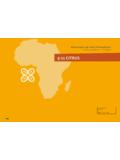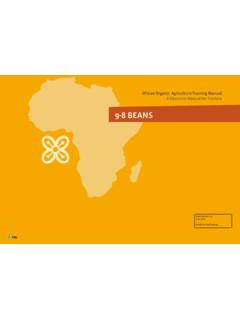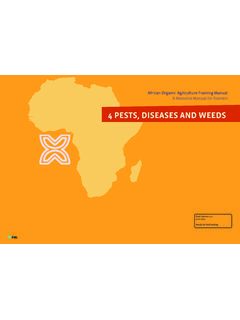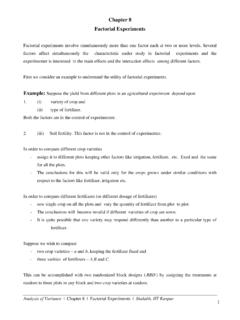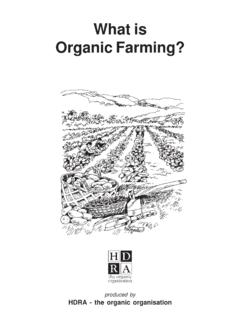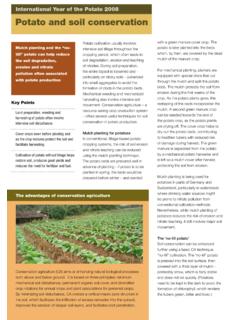Transcription of African Organic Agriculture Training Manual - Banana
1 9-19 BANANAA frican Organic Agriculture Training ManualA Resource Manual for TrainersDraft Version 2011 Ready for field testingAfrican Organic Agriculture Training Manual Module 09 Crops Unit 19 BananaCONTENTS1. Introduction 32. Improving management of Banana pests and diseases 43. Improving the productivity of the Banana plantation 12 4. Proper postharvest handling 165. Increasing returns from Banana production 166. Marketing and Organic certification of Banana production 17 IMPRINTP ublisher:FiBL, Research Institute of Organic Agriculture , Switzerland, :> IFOAM, International Federation of Organic Agriculture Movements, Germany, > NOGAMU, National Organic Agricultural Movement of Uganda, > FENAB, Senegal> OPPAZ, Organic Producers and Processors Association of Zambia, author: Brian SsebunyaReviewer: Jane Nalunga (Nogamu)Illustrator:Andrew BainganaDraft version , September 2011.
2 This is an interim version. Comments and recom-mendations for improvement are Manual chapter can be reproduced without permission. All materials resulting from the Africa Organic Agriculture Training Manual project are available free of charge in the internet under production of this Manual was funded by the Bill and Melinda Gates Foundation and the Syn-genta Foundation for Sustainable Agriculture with the goal to promote Organic farming in the information contained in this Manual has been compiled by the authors to the best of their knowledge. Reasonable efforts have been made by the Research Institute of Organic Agriculture and their partners to publish reliable data and information. The authors, the editors and the pub-lishers cannot assume responsibility for the valid-ity of the materials. Neither the authors, nor the publishers, nor anyone else associated with this publication, shall be liable for any loss, damage or liability directly or indirectly caused or alleged to be caused by the Training Manual and its African Organic Agriculture Training Manual is based on research funded by the Bill & Melinda Gates Foundation and the Syngenta Foundation for Sustainable Agriculture .
3 The Manual s findings, conclusions and recommendations are those of the authors, and do not necessarily reflect posi-tions or policies of either cite this publication as follows: FiBL (2011): African Organic Agriculture Training Manual . Version June 2011. Edited by Gilles Weidmann and Lukas Kilcher. Research Institute of Organic Agriculture FiBL, FrickISBN 978-3-03736-197-9 African Organic Agriculture Training Manual Module 09 Crops Unit 19 Banana19-19 BANANAL earning targets for farmers: >Understand good management practices of bananas >Understand how to better manage Banana pests and diseases >Acquire knowledge on improving productivity of Banana plantations >Receive guidance on marketing and Organic certification of Banana produc-tion1 Introduction Banana (Musa species) is a very important crop in sub-Saharan Africa, especially Eastern Africa, where besides consumption as food, bananas have cultural and medicinal values.
4 There are many types of bananas grown in Africa, but depend-ing on how bananas are utilised, they can be broadly grouped as follows: >Dessert bananas They include Cavendish, Red Bananas, Apple bananas and Gros Michel. These are consumed as ripe fruits (table bananas). Most cultivars are susceptible to nematodes, Sigatoka leaf spots and Fusarium wilt although they are generally tolerant to weevil attack. Cavendish cultivars are the most popular and valuable of the dessert bananas and are traded worldwide. >Cooking bananas They include the East African highland bananas (EAHB) and many other types of plantains consumed as cooked or roasted bananas. The EAHB are said to be endemic to the East African region and grow comfort-ably at higher altitudes (above 1000 m). On the other hand, most plantains are lowland varieties and are very susceptible to weevil attack. >Beer bananas These cultivars can perform well even in suboptimal condi-tions and are used mostly for production of Banana juice which is directly consumed or used for making Banana beer, wine or spirits.
5 >Multipurpose bananas They include a number of improved cultivars such as the FHIA hybrids. These have multiple uses from being used as dessert ba-nanas to juice production. They are relatively tolerant to 19: Banana African Organic Agriculture Training Manual Module 09 Crops Unit 19 Banana2 Bananas are a perennial tropical and subtropical crop, which grow in a wide range of environments. However, the Banana production systems can be divided into three broad categories depending on the number of cultivars grown and the intensity of Backyard garden systemsHere Banana is grown in a highly integrated system especially in peri-urban are-as where land is limited. Bananas are grown mainly for food in combination with other enterprises like zero grazed animals or vegetable gardens to supplement nutritional or peri-urban market needs. This is a low input system and normally no proper pest and disease management is Perennial agroforestry systemsIn this system, bananas are intercropped with mainly perennial crops like cof-fee, vanilla, cocoa or fruit trees.
6 In this system, bananas serve as a middle storey shade crop, but also provide food for household needs. Any excess is sold to the market. Different cultivars are normally grown together depending on the loca-tion and the intended use of the bananas. The plants are not replaced until they die of senescence or pests and diseases. This is also a low input system and many pests and diseases are either partially controlled or not controlled at all, making Banana production highly vulnerable. However, it is the most common produc-tion system in most Banana producing areas in Commercial plantationsThese are normally single cultivar monoculture systems, comprising mostly dessert Banana cultivars which have good export potential. Management of these plantations characterised by careful selection of cultivars/varieties and intensive use of synthetic fertilizers and pesticides.
7 In this system, well-defined crop cycles are also observed, usually lasting 2 to 5 years after which all plants are uprooted and to Banana production in africaProduction of bananas in Africa is, however, threatened by many challenges, in-cluding: >Several important pests and diseases Pests and diseases are the main threat to Banana production. Traditional Banana cultivars have been severe-ChaLLENgES FaCINg Banana PRODuCTION POOR Banana PRODuCTION PRaCTICESA frican Organic Agriculture Training Manual Module 09 Crops Unit 19 Banana3 Discussion: assessment of the local situation Inquire about the local practices in Banana pro-duction and especially about the common chal-lenges faced in Banana production asking the farmers the following questions: >Do you experience any of the above or other challenges? >How have they tried to address them?ly damaged by a wide range of pests and diseases, resulting in heavy yield losses.
8 For example, bacterial wilt and Fusarium wilt are serious threats in many sub-Saharan African countries leading to 100 % losses. Nematodes, ba-nana weevils, Sigatoka leaf spots and Banana bunchy top virus disease have also caused immense damage to plantations. Most farmers lack information on proper management of these infections so they continue to spread them unknowingly. >Low productivity of Banana plantations Low productivity is mainly due to poor soil fertility management, water conservation and husbandry practices. In highland areas, Banana plantations are not terraced and yet many trees are cut out of the garden. Running water from uphill washes down the topsoil and mulch. The soil remains exposed and its water storage capacity is gradu-ally reduced, and yet bananas require good soil moisture for proper growth. Many suckers are left per Banana stool, pruning and removal of male buds is either done late or not at all.
9 Crop cycles are not regulated whereby the same garden of bananas is left for a long time without rotation or replanting. Suckers for establishing new gardens are carried with all their roots from one village to another, thereby spreading pests and diseases. >hailstorm and wind damage Bananas have shallow spreading roots, weak stems and leaves. This makes them very susceptible to strong winds and hail-storms especially during the fruit bearing stage. This is a common problem in monoculture Banana plantations where trees are cut for other purposes and in highland , especially the cooking and dessert bananas are widely consumed in Africa and are a source of livelihood for many people. The challenges mentioned above facing Banana production need to be addressed to ensure sustainable and profitable Banana production and utilization. This chapter therefore introduces Organic approaches to Banana production challenges, which can be adapted to local conditions.
10 IMPROVED Banana PRODuCTION PRaCTICES African Organic Agriculture Training Manual Module 09 Crops Unit 19 Banana4AA Discussion on local management of common Banana pests and diseases Try to find out the most problematic pests and diseases in the area ask-ing the following ques-tions: >Which Banana pests and diseases are com-mon in the area? >How do you prevent the introduction or spread of these pests or dis-eases? >What do you do when an infection is identified in the Banana planta-tion?2 Improving management of Banana pests and diseasesBananas are susceptible to a wide range of pests and diseases. Some of these pests and diseases are highly destructive and very contagious (easily spread), and once introduced they are persistent and difficult to eradicate. In general, the severity and occurrence of pest outbreaks and plant damage depends on the prevailing environmental conditions, specific Banana cultivars, and the specific disease or pest.
